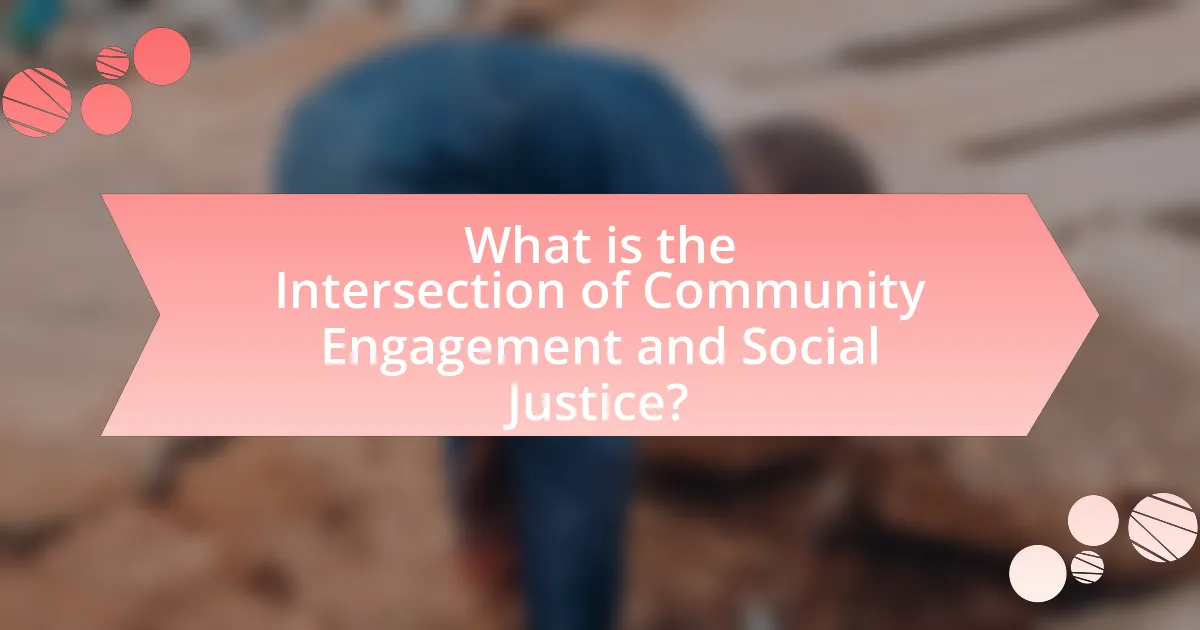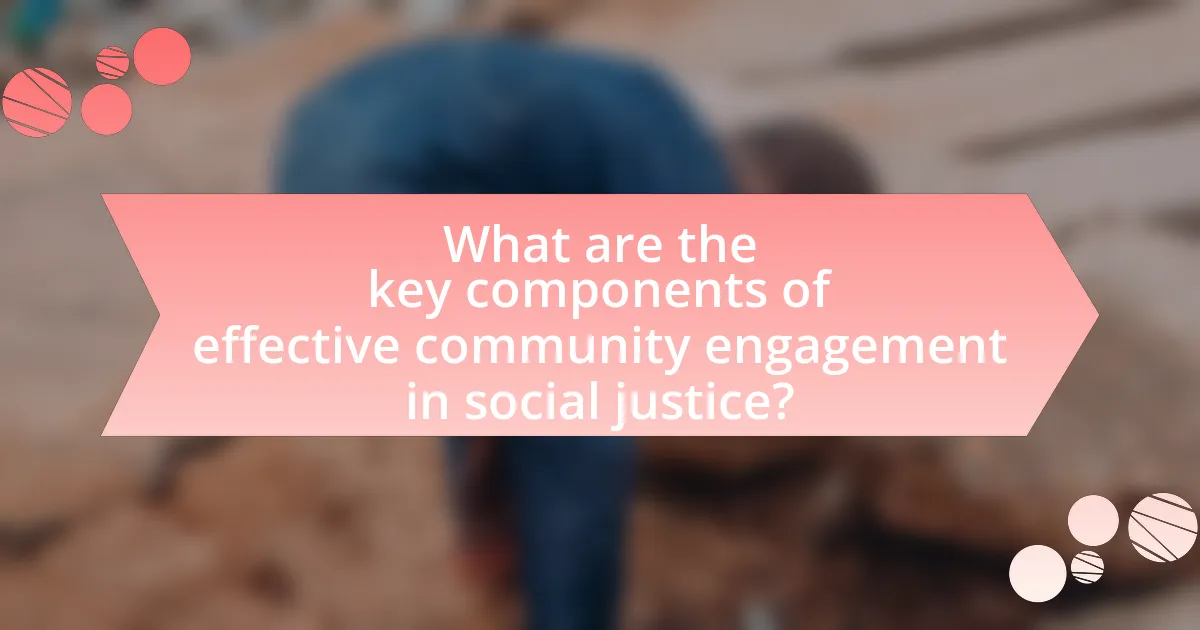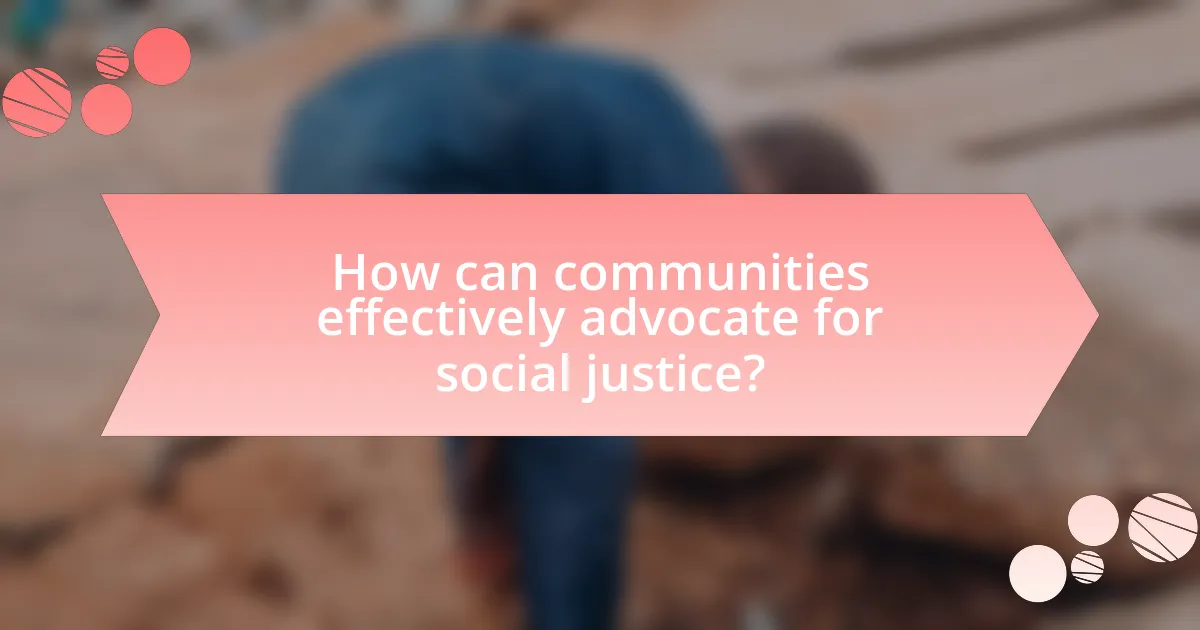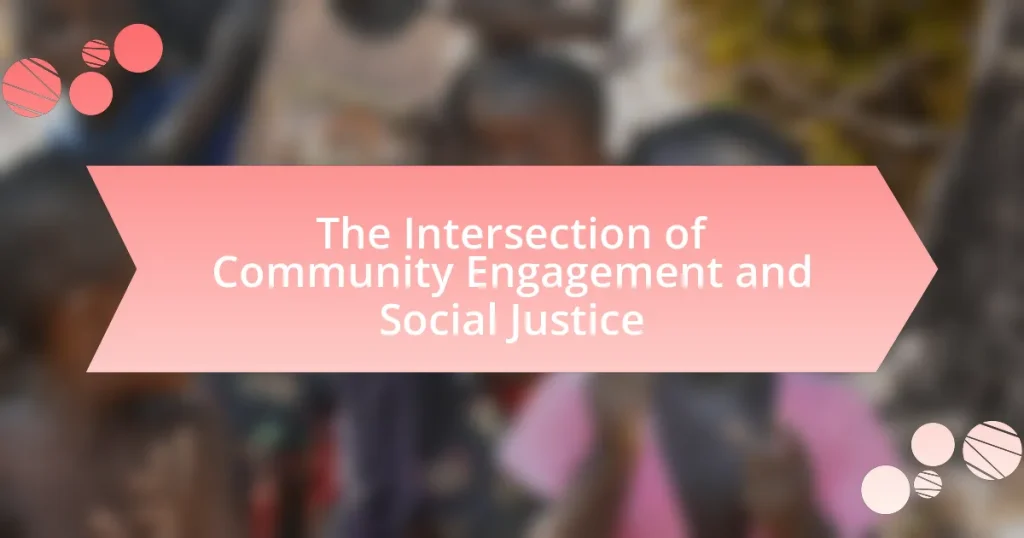The article explores the intersection of community engagement and social justice, emphasizing their collaborative role in addressing systemic inequalities and empowering marginalized communities. It highlights how community engagement fosters active participation, ensuring diverse voices are included in decision-making processes, which is vital for achieving social justice. The article examines historical contexts, varying definitions of social justice across different communities, and the importance of effective engagement strategies. Additionally, it discusses the challenges faced by communities, the impact of grassroots organizing, and the measurable outcomes of community involvement in social justice initiatives. Key components for successful advocacy and practical steps for enhancing engagement are also outlined, providing a comprehensive understanding of how these elements contribute to societal change.

What is the Intersection of Community Engagement and Social Justice?
The intersection of community engagement and social justice lies in the collaborative efforts of individuals and groups to address systemic inequalities and empower marginalized communities. Community engagement fosters active participation, ensuring that diverse voices are heard in decision-making processes, which is essential for achieving social justice. For instance, initiatives like participatory budgeting allow community members to influence how public funds are allocated, directly impacting social equity. Research indicates that communities with higher levels of engagement experience improved social outcomes, as seen in studies by the National Civic League, which highlight the correlation between civic participation and enhanced community well-being.
How do community engagement and social justice relate to each other?
Community engagement and social justice are interconnected as both aim to empower marginalized groups and promote equitable access to resources and opportunities. Community engagement involves active participation of individuals in decision-making processes that affect their lives, fostering a sense of ownership and responsibility. This participation is essential for achieving social justice, which seeks to address systemic inequalities and ensure fair treatment for all individuals, particularly those who have been historically oppressed. Research indicates that effective community engagement can lead to improved social outcomes, as seen in initiatives that have successfully mobilized communities to advocate for policy changes that enhance social equity.
What are the historical contexts of community engagement in social justice movements?
Community engagement in social justice movements has historically emerged from grassroots activism aimed at addressing systemic inequalities. For instance, during the Civil Rights Movement in the 1960s, community engagement was pivotal as local leaders mobilized citizens to challenge racial segregation and advocate for voting rights, exemplified by events like the Selma to Montgomery marches. Additionally, the labor movement in the early 20th century showcased community engagement through collective bargaining and strikes, where workers united to demand fair wages and working conditions, significantly influencing labor laws. These historical contexts illustrate how community engagement has been a fundamental mechanism for marginalized groups to assert their rights and drive social change.
How do different communities define social justice?
Different communities define social justice as the equitable distribution of resources, opportunities, and rights among all individuals, emphasizing fairness and inclusivity. For instance, marginalized communities often view social justice through the lens of addressing systemic inequalities, advocating for policies that dismantle barriers related to race, gender, and socioeconomic status. In contrast, religious communities may frame social justice as fulfilling moral obligations to care for the less fortunate, aligning with teachings that promote compassion and charity. Additionally, indigenous communities frequently emphasize the importance of land rights and cultural preservation as integral to their understanding of social justice. These varied definitions reflect the unique historical, cultural, and social contexts of each community, underscoring the complexity of the concept.
Why is the intersection important for societal change?
The intersection of community engagement and social justice is crucial for societal change because it fosters collaboration among diverse groups to address systemic inequalities. This collaboration enables marginalized voices to be heard, ensuring that solutions are inclusive and representative of the community’s needs. Research shows that initiatives combining community engagement with social justice principles lead to more effective policy changes and sustainable outcomes, as evidenced by the success of grassroots movements that have transformed local policies in areas such as housing and education.
What role does community engagement play in promoting social justice?
Community engagement plays a crucial role in promoting social justice by fostering inclusive participation and empowering marginalized voices. Engaged communities can identify their unique challenges and advocate for equitable policies, leading to systemic change. For instance, research by the National Civic League indicates that communities with high levels of engagement experience improved social cohesion and increased civic participation, which are essential for addressing social injustices. Additionally, community engagement initiatives often facilitate collaboration among diverse groups, enhancing collective action towards achieving social equity.
How can social justice initiatives benefit from community involvement?
Social justice initiatives can benefit from community involvement by enhancing their effectiveness and sustainability. Community engagement fosters a sense of ownership among residents, leading to increased participation and support for initiatives. For example, research by the National Civic League indicates that communities with high levels of civic engagement experience better outcomes in social justice efforts, as local insights and experiences inform strategies that are more relevant and impactful. Additionally, community involvement can mobilize resources and networks that amplify the reach and effectiveness of social justice initiatives, as evidenced by successful grassroots movements that have led to policy changes and increased awareness of social issues.

What are the key components of effective community engagement in social justice?
The key components of effective community engagement in social justice include inclusivity, transparency, collaboration, and empowerment. Inclusivity ensures that diverse voices, particularly those from marginalized groups, are represented in decision-making processes. Transparency fosters trust by openly sharing information and processes with the community. Collaboration involves building partnerships among community members, organizations, and stakeholders to address social justice issues collectively. Empowerment equips individuals with the knowledge and skills necessary to advocate for their rights and influence change. Research indicates that these components lead to more sustainable and impactful social justice initiatives, as evidenced by successful community-led movements that have resulted in policy changes and increased awareness of social issues.
What strategies enhance community participation in social justice efforts?
Strategies that enhance community participation in social justice efforts include fostering inclusive dialogue, building trust through transparency, and providing accessible resources for education and advocacy. Inclusive dialogue encourages diverse voices to contribute, ensuring that all community members feel valued and heard. Building trust through transparency involves open communication about goals, processes, and outcomes, which can increase community buy-in and participation. Providing accessible resources, such as workshops and informational materials, empowers individuals with the knowledge needed to engage effectively in social justice initiatives. Research indicates that communities with strong participatory frameworks see higher levels of engagement and successful outcomes in social justice campaigns, as evidenced by studies conducted by the National Civic League, which highlight the correlation between community involvement and effective social change.
How can grassroots organizing empower communities?
Grassroots organizing empowers communities by fostering collective action and enabling individuals to advocate for their rights and needs. This form of organizing mobilizes local residents to identify issues, build networks, and create solutions that reflect their unique circumstances. For instance, the Civil Rights Movement in the United States demonstrated how grassroots efforts led to significant legislative changes, such as the Voting Rights Act of 1965, which was driven by community-led initiatives. By providing a platform for marginalized voices, grassroots organizing enhances civic engagement, promotes social justice, and cultivates leadership within communities.
What tools and resources are available for effective engagement?
Effective engagement can be achieved through various tools and resources, including digital platforms, community workshops, and social media campaigns. Digital platforms like Zoom and Microsoft Teams facilitate virtual meetings and discussions, allowing for broader participation. Community workshops provide hands-on experiences that foster collaboration and understanding among participants. Social media campaigns, utilizing platforms such as Facebook and Twitter, enable organizations to reach wider audiences and mobilize support for social justice initiatives. Research indicates that these tools enhance communication and participation, leading to more impactful community engagement efforts.
What challenges do communities face in engaging with social justice issues?
Communities face several challenges in engaging with social justice issues, including lack of resources, limited access to information, and systemic barriers. These challenges hinder effective participation and advocacy. For instance, many communities may lack funding for initiatives or programs that promote social justice, which can limit their ability to mobilize and organize effectively. Additionally, misinformation or a lack of awareness about social justice issues can prevent community members from understanding the importance of engagement. Systemic barriers, such as institutional racism or socioeconomic disparities, further complicate efforts by creating environments where marginalized voices are often silenced or overlooked. These factors collectively impede communities from fully engaging in social justice efforts and advocating for meaningful change.
How do systemic barriers impact community engagement?
Systemic barriers significantly hinder community engagement by creating obstacles that prevent equitable participation. These barriers, such as socioeconomic disparities, racial discrimination, and lack of access to resources, limit the ability of marginalized groups to engage in decision-making processes. For instance, a study by the National Civic League found that communities with higher levels of income inequality experience lower rates of civic participation, demonstrating a direct correlation between systemic barriers and reduced community involvement.
What are common misconceptions about community involvement in social justice?
Common misconceptions about community involvement in social justice include the belief that participation is only for activists or that it requires extensive resources and time. Many people think that only those with formal training or experience can contribute effectively, which overlooks the value of grassroots efforts and diverse perspectives. Additionally, some assume that community involvement is limited to protests or large-scale events, ignoring the impact of smaller, everyday actions such as volunteering or local advocacy. Research shows that inclusive community engagement can lead to more effective social justice outcomes, as diverse voices contribute to a richer understanding of issues and solutions.

How can communities effectively advocate for social justice?
Communities can effectively advocate for social justice by organizing collective actions, raising awareness, and engaging in policy advocacy. Collective actions, such as protests and community meetings, mobilize individuals around shared goals, fostering solidarity and amplifying voices. For instance, the Black Lives Matter movement has successfully utilized grassroots organizing to highlight systemic racism and push for legislative changes. Raising awareness through educational campaigns and social media can inform the public about social justice issues, as seen in campaigns like #MeToo, which brought attention to sexual harassment and assault. Engaging in policy advocacy involves collaborating with local governments and organizations to influence legislation, exemplified by community coalitions that have successfully lobbied for reforms in criminal justice and housing policies. These strategies demonstrate that organized, informed, and collaborative efforts can lead to meaningful social change.
What are the best practices for community-led advocacy?
The best practices for community-led advocacy include fostering inclusive participation, building strong relationships, and utilizing data-driven strategies. Inclusive participation ensures that all community members, especially marginalized voices, are engaged in the advocacy process, which enhances the legitimacy and effectiveness of the efforts. Building strong relationships among community members and with external stakeholders creates a supportive network that can amplify advocacy messages and mobilize resources. Utilizing data-driven strategies involves collecting and analyzing relevant data to inform advocacy efforts, making them more persuasive and targeted. For instance, research by the National Civic League highlights that communities with strong engagement practices are more successful in achieving policy changes, demonstrating the effectiveness of these best practices in real-world scenarios.
How can storytelling be used as a tool for advocacy?
Storytelling can be used as a tool for advocacy by effectively conveying personal experiences and emotions that resonate with audiences, thereby fostering empathy and understanding. This method allows advocates to illustrate complex social issues in relatable terms, making the challenges faced by marginalized communities more tangible. For instance, narratives shared by individuals affected by social injustices can humanize statistics, creating a compelling case for change. Research by the FrameWorks Institute indicates that stories can shift public perceptions and influence policy decisions by framing issues in a way that highlights the human impact, thus driving engagement and action.
What role does collaboration play in successful advocacy efforts?
Collaboration is essential for successful advocacy efforts as it amplifies voices, resources, and expertise. When diverse stakeholders, including community members, organizations, and policymakers, work together, they create a unified front that enhances credibility and influence. For instance, coalitions formed during the civil rights movement effectively combined efforts from various groups, leading to significant legislative changes. This collective action not only increases visibility but also fosters shared ownership of goals, making advocacy initiatives more impactful and sustainable.
What are the measurable impacts of community engagement on social justice outcomes?
Community engagement significantly enhances social justice outcomes by increasing civic participation, fostering collaboration, and amplifying marginalized voices. Research indicates that communities actively involved in decision-making processes experience improved access to resources and services, leading to equitable outcomes. For instance, a study by the National Civic League found that cities with strong community engagement initiatives reported a 30% increase in public trust and a 25% improvement in the perceived effectiveness of local government. Additionally, community-led advocacy efforts have been shown to influence policy changes, as evidenced by the successful campaigns for affordable housing in various urban areas, which resulted in increased funding and legislative support. These measurable impacts demonstrate that community engagement is a critical factor in advancing social justice.
How can communities assess the effectiveness of their engagement strategies?
Communities can assess the effectiveness of their engagement strategies by utilizing metrics such as participation rates, feedback surveys, and outcome evaluations. Participation rates provide quantitative data on how many individuals are involved in engagement activities, indicating the level of interest and outreach effectiveness. Feedback surveys allow community members to express their perceptions and satisfaction with the engagement process, offering qualitative insights into its impact. Outcome evaluations measure the tangible results of engagement efforts, such as changes in community behavior or policy influence, thereby demonstrating the strategies’ effectiveness in achieving desired social justice goals. These methods collectively provide a comprehensive understanding of engagement strategy effectiveness.
What indicators show progress in social justice initiatives?
Indicators that show progress in social justice initiatives include increased representation of marginalized groups in decision-making processes, improved access to education and healthcare, and measurable reductions in income inequality. For example, the U.S. Census Bureau reported that from 2010 to 2020, the percentage of elected officials from diverse backgrounds increased, reflecting greater representation. Additionally, studies indicate that areas with community engagement initiatives often see enhanced educational outcomes and health access, as evidenced by the 2019 report from the National Equity Atlas, which highlighted improvements in educational attainment among low-income communities. Furthermore, the Gini coefficient, a measure of income inequality, has shown a gradual decline in several regions where social justice initiatives have been actively implemented, indicating progress toward economic equity.
What practical steps can communities take to enhance engagement in social justice?
Communities can enhance engagement in social justice by organizing educational workshops that raise awareness about social issues. These workshops can provide information on topics such as systemic inequality, discrimination, and community rights, fostering informed discussions among participants. Research indicates that communities that engage in educational initiatives see a 30% increase in civic participation, as individuals become more aware of their rights and responsibilities. Additionally, forming partnerships with local organizations can amplify outreach efforts, creating a network of support that encourages active involvement in social justice initiatives.
